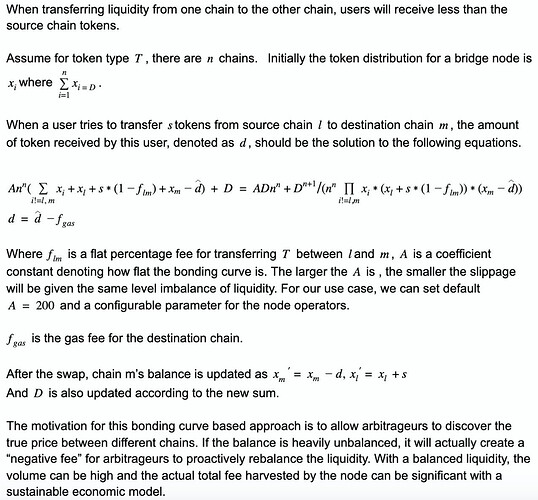The testnet of Layer2.finance was very helpful in helping us identify some bugs in the system. Fortunately, none of these bugs are related to security but more within the backend system correctness. We have been doing upgrades and iterations to fix these issues and are now doing rigorous testing to make sure no other issues are spotted. In the meantime, we are adding a lot more DeFi strategies to integrate with layer2.finance. The reason we want to have a wide range of strategies when we upgrade to v1.0 is to ensure there is a long-term network effect for users to stay in layer2.finance. After all, strategies are ready, we will launch on the mainnet with liquidity mining! As previously mentioned, liquidity mining is geared towards rewarding not only whales but also normal users. We are shooting for more users rather than a few whales with a lot of liquidity to get all the gains of the liquidity mining rewards. Our spirit goes towards bringing DeFi to the masses.
For cbridge.celer.network, things are very exciting! We have launched cBridge for less than a week and it has bridged $1.2M in volume for users across BSC, Matic, and Ethereum. With a day-over-day growth of 2X. Yesterday included, cBridge has bridged $0.5M volume and we expect it to continuously grow from here. We have a lot of interested parties from dApps, exchanges, chains, and wallets integrating with cBridge. You can see some of the biggest wallets in the world already integrated with cBridge such as imToken and TokenPocket.We are talking to quite some multi-chain dApps (gaming, DeFi and, NFT) to integrate an entry point for their users to seamlessly bridge assets across chains and hopefully, you guys will start to see them popping up soon!
We will also have an analytics dashboard soon so everyone can see the volume growth in real-time.
Now, there are also a lot of interested parties wanting to run a cBridge node and harvest yield. So we expect more nodes to come soon as well!
Some layer2 applications interfere with major platforms. Can your project be technically integrated into the stock market, swap, game projects? (Technically)
For sure, if you look at layer2.finance, it is at this time integrating with DeFi protocols and more will be integrated into the v1.0 upgrade. We are wrapping up the testnet and will have a plan for the mainnet upgrade soon after that.
For cBridge (cbridge.celer.network), we are integrating with multiple exchanges’ chains like BSC and more will come as we expand this multi-chain interoperability layer. If you have not used cbridge.celer.network yet, I strongly recommend you try it out!
When is layer2.finance v1.0 coming?
After we complete testing, wrap up the bug fixes and integrate layer2.finance with more DeFi strategies. So we can be ready for the launch and liquidity mining campaign. Expect a timeline of one month.
Celer has a few products instantiated, but which do you see generating the greatest ROI and who do you personally consider to be your competitor(s) in that space?
Right now we believe both layer2 scaling and interoperability between different chains and layer2s are the most important topic going forward. So layer2.finance and cbridge.celer.network will be our key focus. In terms of competitors, for layer2.finance, there are a lot of aggregators in this space with similar UI (you can invest in different strategies or DeFi products on a single UI) However, what makes Celer’s layer2.finance unique is that it uses layer2 scaling technology to make the cost of transaction much lower than directly interacting with a DeFi protocol. For all the existing aggregators for example Instadapp, it is actually making it more expensive to deposit and withdraw from those protocols.
Now for cBridge, there are a lot of cross-chain solutions out there such as Thorchain and Chainswap. Due to some design complexity, some of these have gotten hacked. What makes cBridge different is its very robust architecture, rooted in Celer’s State Channel design, and can be elegant and safe with the capability for anyone to join the cBridge nodes network and provide liquidity.
Will fees generated from Celer products ever be distributed to all token holders, similar to how dividends function in traditional finance? Such value accrual could be instrumental in reducing sell pressure and developing more interest in the entire Celer ecosystem.
The key infrastructure of Celer is SGN. State Guardian Network (SGN) is a decentralized L2 service infrastructure. It serves multiple purposes essential to the Celer L2 platform’s smooth operation. First, it serves as a decentralized “watchtower” service that ensures users’ state in the Celer State Channel Network is safely stored and responds to any L1 settlements when users are offline. Second, it serves as a decentralized block producer layer for Celer Rollup to ensure a high level of liveness, incentive-compatible block producer election, and finally an additional layer of security. Users are required to stake CELR tokens to join SGN and earn fees for providing related services.
Is there a list of dApps that are to be deployed on Celer Network, and if so, is there somewhere we can cast votes for ones we would like to see integrated? Or perhaps there could be a Gitcoin like platform where users contribute to a pool of funds to be distributed as a bounty to whoever decides to build it?
For sure, CELR will also be used as governance tokens to vote for which DeFi strategies our users want for layer2.finance and which chains our users want to add for cbridge.celer.network.
We are starting to set up things at forum.celer.network and voting through Snapshot.
There will be interesting things like voting whether a DeFi project wants to collaborate for a liquidity mining campaign to mine both CELR and their liquidity tokens through layer2.finance.
Is the timeline for Layer2.finance v1.0 release within August?
We are hoping to see it roll out in that timeline, yes. However, we would want to have layer2.finance v1.0 come out with a bang. So reliability and a diversified set of strategies will be very important for us during this upgrade.
For people who are currently staking in SGN how would the transition into Layer2 v1.0 go, if possible at all? Would we have to withdraw and re-Stake?
There is no need to re-stake!
Are all these minimum balance requirements necessary for all tokens and all chains? Or the node can work with a single token on 2 chains? What is the recommended practice for small liquidity nodes?
Even a single token on a single chain will work. Nodes can be online or offline and do not need to have a public IP address. So even running a node on your laptop would be an option.
If all liquidity is concentrated on one chain and there is no available liquidity to bridge to a certain chain, what will happen then?
One way to look at this is for the same kind of token, let’s say USDT, when it is on different chains, it essentially gets “forked” into multiple different tokens. Such as “USDT-Polygon”, “USDT-Ethereum”, “USDT-BSC”. The demand for this token on a particular chain might be high and people want to transfer it there. Now, this is where the smart slippage pricing we are releasing soon for cBridge will come into play. We will use a similar formula such as Curve, to control the pricing of this multi-chain swap. So when one side of liquidity is highly unbalanced, the bridging cost (slippage) will be higher, so basically, you can get 0.95 USDT-polygon by transferring 1 USDT-BSC for example.
Now this kind of AMM-like pricing mechanism will create opportunities for arbitrageurs to insert correct liquidity or reverse the liquidity direction in certain cases to make the network more or less balanced. Of course, it cannot ensure it is always 100% balanced (just like Curve), but it will help the slippage and also the overall balance of the network by using this dynamic pricing based on the AMM slippage curve.
Would it require these variables to be dynamic instead of plain config parameters?
The slippage part of the “fee” is automatically adjusted based on an AMM curve. So operators do not need to configure them. And there is a base fee that is just a constant value.
Here is our unpublished technical doc (publishing soon)
Have you heard of alchemix.fi? Considering its architecture, is it ever something that you see implemented on a later iteration of Celer Network?
Alchemix is a DeFi protocol to lend out tokens based on future yield. We thought about integrating layer2.finance with them and still investigating the possibility. We like Alchemix, however, their contract does not allow other contracts to call them, so there is no other protocol that can integrate with them, which is quite unfortunate.
Celer entered into a partnership with Matic over two years ago. Is the partnership still ongoing?
Cbridge.celer.network has integrated with Matic network! If you want to withdraw your funds from Matic to Ethereum or bridge Matic funds to BSC or back, you don’t need to wait for 8 hours. Instead, 3 minutes is all you need to wait.
Have you thought about rebranding, what does celer mean?
It starts with some knowledge about the letter c. The letter c stands for speed of light in vacuum, why c? The answer is that it is the initial letter of celeritas, the Latin word meaning speed. Celer = Celeritas.
As far as strategies for Layer.2, How would they be different from using SGN? SGN currently offers about 11% APY. Could these strategies offer a higher percentage or something similar to Pancakeswap?
With the launch of v1.0 and liquidity mining, we hope so, yes. But SGN will remain to be the key infrastructure to ensure the safety and smoothness of layer2 transactions and operations.
Celer is focused on L2 development, is Celer planning completely new directions of development not related to L2? Developments that have not yet seen a breakthrough, where there is no great competition.
We are always exploring the frontiers!


